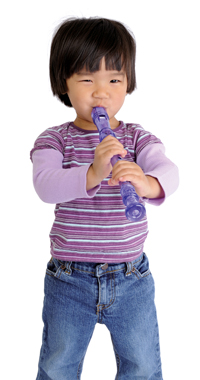 Aubrey Peterson gathers moms and kids into a circle around her. “Where is Alex?” she sings, as the other moms join in. Two-year-old Alex jumps up, beaming, and shouts, “Here I am!” One by one, each child is welcomed to Music Time, a co-operative group run by local moms who want their toddlers to experience music.
Aubrey Peterson gathers moms and kids into a circle around her. “Where is Alex?” she sings, as the other moms join in. Two-year-old Alex jumps up, beaming, and shouts, “Here I am!” One by one, each child is welcomed to Music Time, a co-operative group run by local moms who want their toddlers to experience music.
Children and music go together, and experts agree that music helps kids learn. “Music and movement aid children in every developmental area: social, emotional, physical, cognitive and language,” says Tacoma Kindermusik instructor Glenda Alley. And music also fosters creativity, says Kristen Murphy, head of the University of Puget Sound Community Music Department, especially when kids make up words, rhythms and songs of their own.
The benefits of early exposure to music
Experts say young children especially benefit from musical exposure. “All children are musical,” says Brigham Young University Associate Music Professor Susan Hobson Kenney, who has consulted for “Sesame Street” and “Lamb Chop,” “and the more experiences they have with music before age 3, the easier music is as they get older.” For instance, Alley finds that her Kindermusik students are better able to master rhythms and match pitch when they later start piano lessons.
There are many ways you can share music with your toddler. At home, you can sing, dance or turn ordinary objects into instruments. Alley suggests using music to soothe a fussy baby, or singing directions such as “Let’s take a bath” or “Let’s eat lunch.” For group music activities, you can find classes at Kindermusik, local libraries or children’s museums in Seattle and Tacoma. Or you can start your own Music Time group.
Peterson and her friend Sundy Preston organized their Music Time group three years ago. “We wanted to expose our kids to different kinds of music,” Peterson says. “We also wanted the kids to practice sharing, cleaning up and following a schedule.” Through trial and error they developed a routine that lasts 30-45 minutes. The group starts with three welcome songs, then moves into songs that include actions, dancing, marching or playing instruments. After about eight songs, they pull out a parachute for games in which the kids shake the parachute or dance underneath. Next comes a quiet song to calm the kids down, a story and a goodbye song. Moms take turns acting as leader, rotating month by month. This allows moms to practice leading, introduce new songs or focus on seasonal activities.
Now Music Time attracts friends from Bellevue, Kirkland, North Bend and Renton. “I really treasure the time I get with my toddler,” says longtime member Dyann Parker. She also finds that the music spills over into her home life. “We’ve sung while counting fingers and toes,” she recounts, “spontaneously added our own verses, and sung Music Time songs in the supermarket to distract the children.”
Starting your own music group
To create your own Music Time routine, choose songs that will work well for kids. Peterson recommends CDs by Wendy Wiseman; her songs “Good Morning,” “I Love Colors,” “Count Your Fingers,” and “Twinkle, Twinkle” have all become Music Time favorites, along with “Octopus” by Charlotte Diamond. Check out ethnic music from the library, and let the kids dance any way they want. March to upbeat music like “Seventy-Six Trombones” or “Stars and Stripes Forever.” Try old classics like “Ring Around the Rosie” or the “Grand Old Duke of York” with accompanying actions. For activity ideas, try “Little Songs for Little Me” by local artist Nancy Stewart; this kit of songs, finger plays, and flannel cutouts is available at Island Books on Mercer Island. Another valuable resource is the book Baby Rhyming Time, in which Newport librarian Linda Ernst scripts complete routines using rhymes, finger plays, songs and books.
Props, instruments and more
For props, bring things from home or pitch in for larger purchases such as a parachute or a set of instruments. Remember, Music Time doesn’t have to be expensive. Kids can help make instruments such as paper-plate tambourines, Easter-egg rattles, or rice-filled rain sticks. Stuffed animals from home can star in “Old MacDonald” or “Teddy Bear, Teddy Bear, Turn Around.” One Music Time mom strung together color chips from Home Depot to accompany a color song.
As your Music Time evolves, discuss the routine with other moms to figure out what’s working and adapt as necessary. When it’s your turn to lead, bring a copy of the song list for reference. Parker also suggests leaders play the music at home to learn the songs and the routine. If you can’t provide a music player, sing the songs yourself. The kids will like it just as well.
The Music Time toddlers get so excited singing, marching and playing instruments that by the end they’re zooming around the room. Peterson turns off the lights and has the children lie down while she plays “Twinkle, Twinkle, Little Star.” After she reads a picture book, everybody sings the goodbye song and Music Time ends. The children don’t even know they’ve been learning language, communication and social skills.
They just know it’s fun.
Loralee Leavitt loves writing, playing the organ and singing with her kids.











